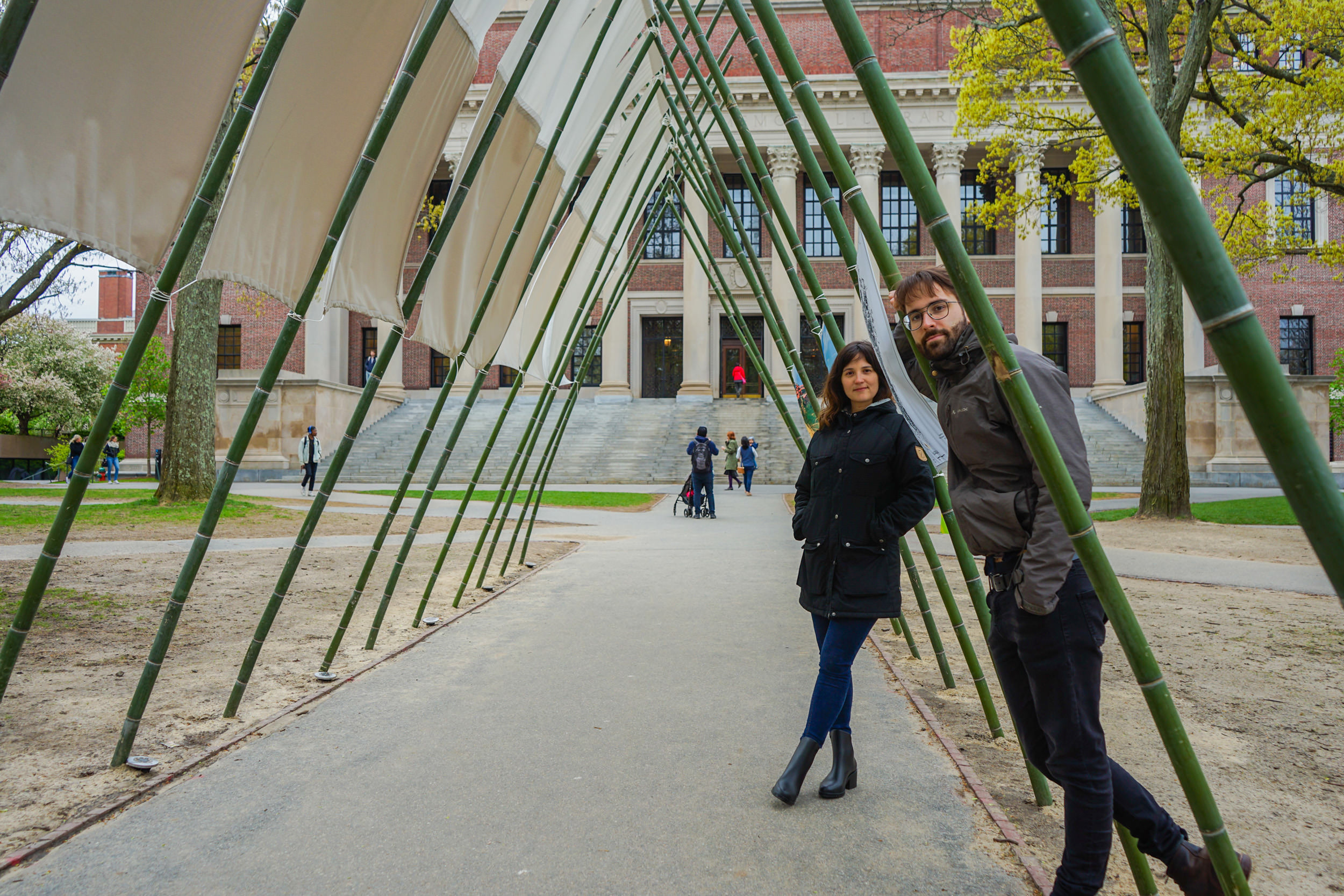
Nadyeli Quiroz (left) and John David Wagner (right) with the Living Form installation on Harvard Yard.
In Bangladesh, hundreds of thousands of Rohingya refugees who have fled Myanmar live in the harsh and unfamiliar conditions of the country’s refugee camps, uncertain of their futures.
At Harvard’s latest Arts First Festival, Mittal Institute student grant recipients Nadyeli Quiroz and John David Wagner unveiled their Living Form sunshade project — an installation that will inform future interventions in the Rohingya refugee camp in Bangladesh.
Quiroz, born in Brazil and raised in Mexico, is an architect studying a Master’s in Landscape Architecture and a Master’s in Design Studies in Urbanism, Landscape, and Ecology at Harvard’s Graduate School of Design. Her interests stem from the relationship of landscape ecology, urbanism, disaster response, and indigenous peoples. Wagner, originally from North Carolina, is a licensed architect in pursuit of a Master’s of Architecture at Harvard’s Graduate School of Design. His interests are rooted in the “convergence of public space, art, justice, and the built environment,” he says.
We recently spoke with Quiroz and Wagner to learn more about their installation and the current crisis that the Rohingya peoples are experiencing in Bangladesh’s refugee camps.
Can you give us some background on the Rohingya peoples and the Kutupalong Refugee Camp in Bangladesh?
The Rohingya Muslim minority from Myanmar have lived in statelessness for over six generations, and are one of the most persecuted minorities in the world. It is estimated that there are one million Rohingyas, and more than 800,000 of them live as refugees in the Cox’s Bazar district of Bangladesh in the largest refugee camp in the world.
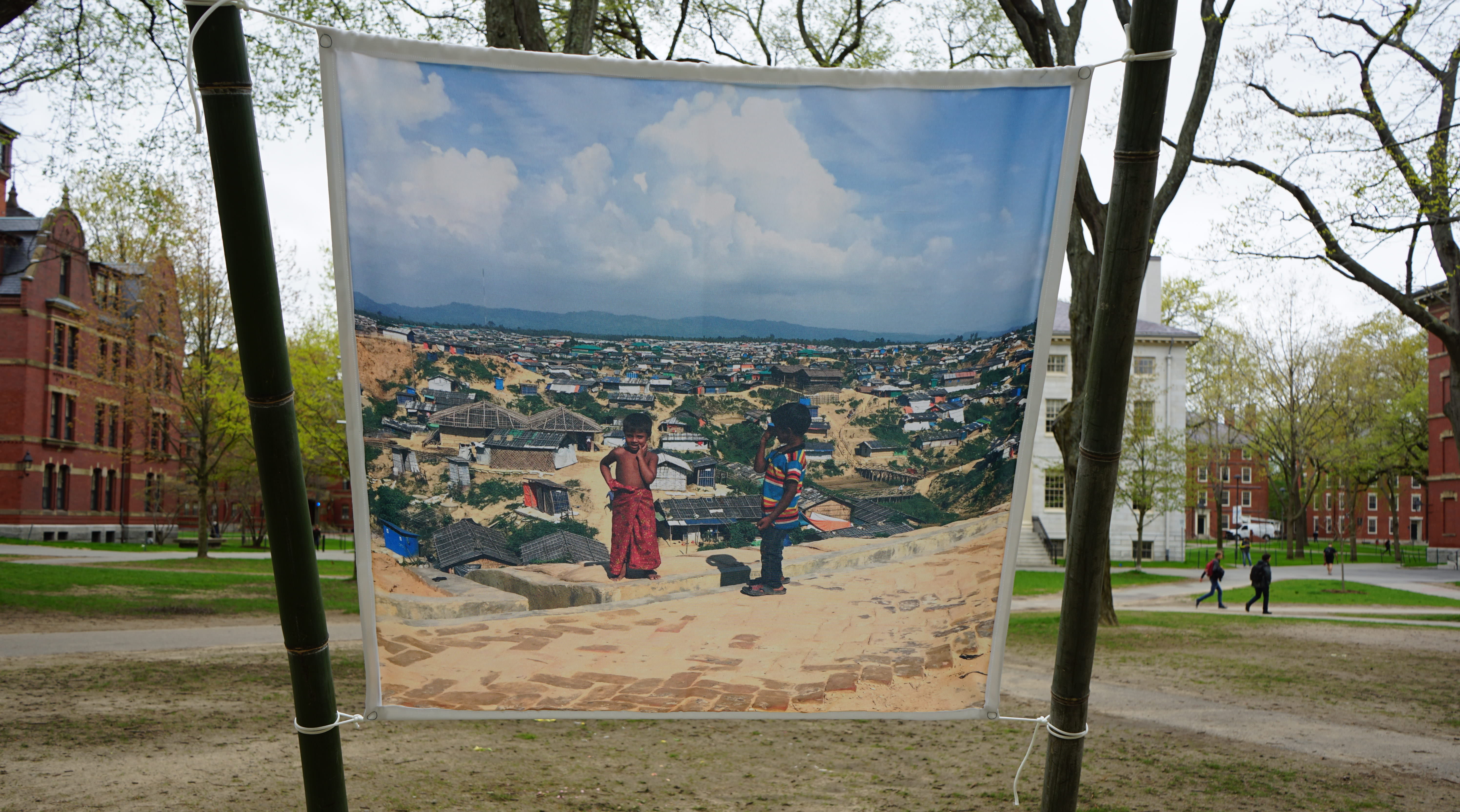
One of the shades in the Living Form installation on Harvard Yard.
The Rohingyas have been denied citizenship since the independence of the Burma State (now Myanmar) in 1948 and have been facing persecution since British colonization in 1825. Today, they are identified as Bengali illegal immigrants in Myanmar, the country that comprises the territory occupied by the Rohingyas since the 8th century. Their exodus [from Myanmar] began in 1978. Prior to 2017, the camp had a total of 113,606 residents. By November 2017, the camp’s population rose by 728,306 people after Myanmar’s military waged a campaign of violence against the Rohingya.
What inspired to you visit Bangladesh and ultimately begin this project?
In September 2018, we had the opportunity to visit the camp as part of a Fall 2018 Option Studio at the Graduate School of Design led by Anna Heringer. As humans, it is an urgent crisis of a myriad of problems that we cannot ignore. With the little experience we can offer, working together on these areas of need after a thorough introduction to this context is imperative.
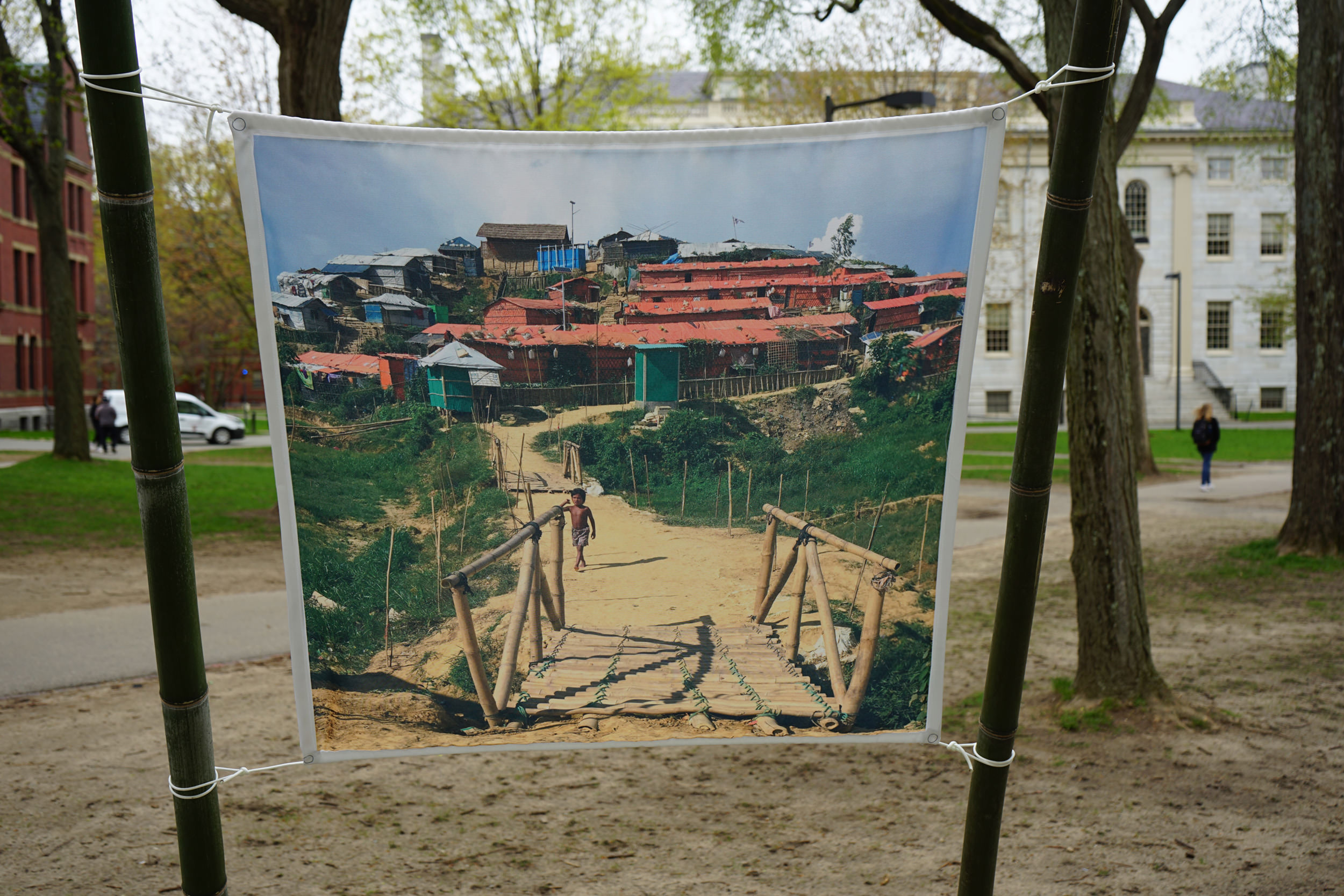
One of the shades in the Living Form installation on Harvard Yard.
What problems did you observe when you visited the camp?
There, we witnessed firsthand the spatial configuration of shelters, public facilities, and infrastructures of water, mobility, and landscape. The landscape has been completely cleared of trees due to the need for cooking fuel, shelter, and space for emergency shelters. As a result, shade is a scarcity in the camp, and most of all the available shading comes from artificial structures that serve as outdoor queues for public programs, such as mosques, clinics, primary schools, and other buildings provided by International NGOs. Devoid of trees, the little shade and scarcity of functional outdoor space is compounded by hazards of landslide, flooding, and erosion.
These scarce public spaces offer little place outside of the home for being and dwelling. Residents, specifically women, are confined either to the specific areas of public program or within their own tents for respite from the sun. We saw children find improvised spaces to play outside during their few daily school hours, searching for shade from the heat and sun. Women and girls have as few as fifteen minutes outside their tents each day — an inhuman captivity. In the high summer heat, this can become unbearable. This is compounded by strict religious and social codes that limit women from appearance and presence in public spaces. There is little by way of privacy, and for women and children even to wash themselves and pass waste is an exposure to personal risk and harm at any hour of the day.
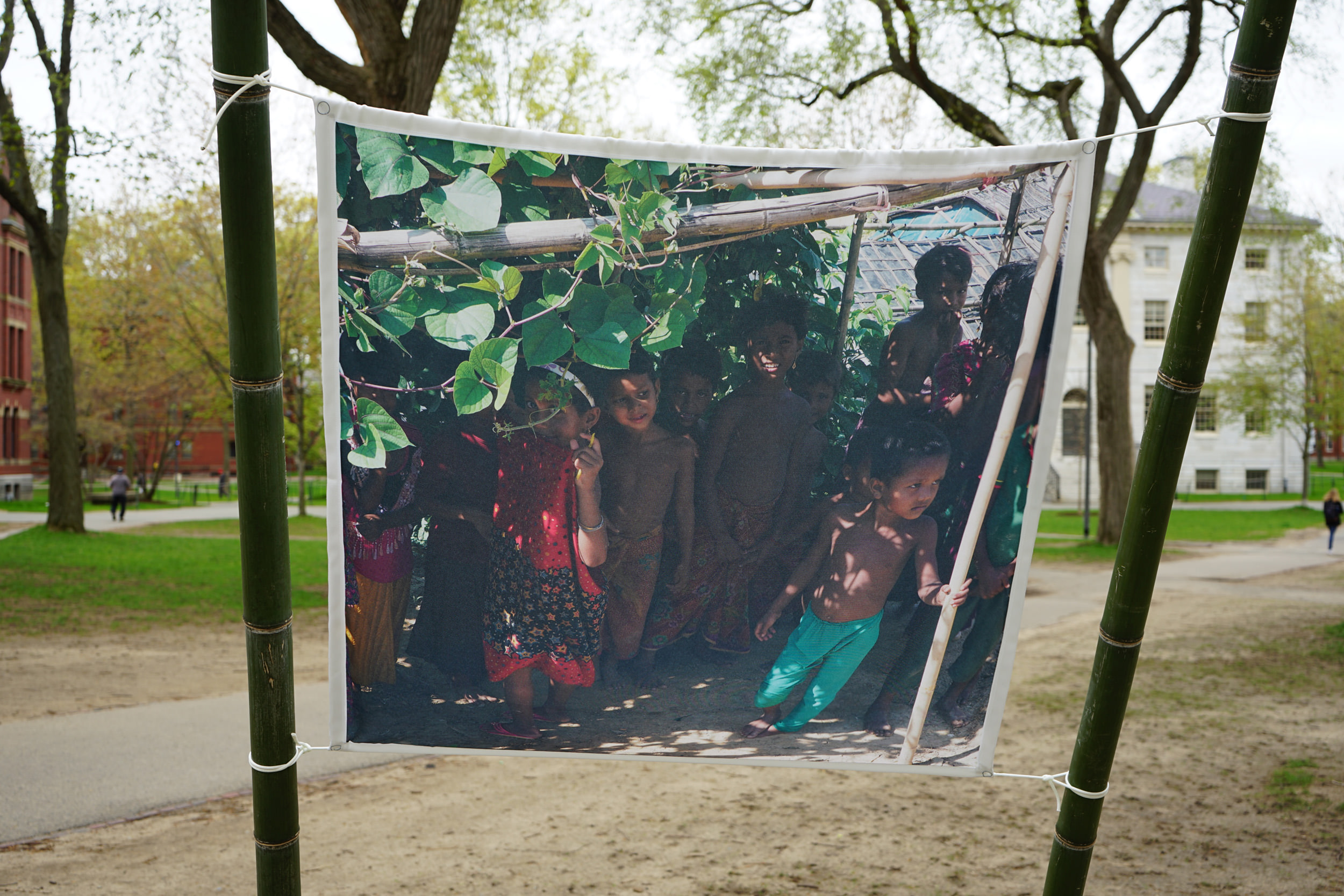
One of the shades in the Living Form installation on Harvard Yard.
In addition to field observations, we learned from native builders the techniques of bamboo assembly and earth construction. We interviewed children and learned of their experiences and memories of life before expulsion from Myanmar. Our conversations with adults — both men and women — revealed discomfort, distress, and dismay at being removed from familiarity and placed into calamity. These discussions revealed firsthand hazards to the safety and welfare of people and their immediate families due to inadequacies in camp security and infrastructure.
Our strongest context was provided through the firsthand accounts and interaction with NGO leadership and staff, specifically those staff who are Rohingya and were from a previous generation living in exile. This point of view from the humanitarian providers underscored urgent needs and revealed oversights in the response effort.
We realized that alongside the urgent medical, shelter, and sanitation needs of the camp provided for by response agencies, there are parallel needs of public and secure areas to serve as community spaces for all members, necessitating a broader ecological landscape management vision and infrastructural plan to provide for the sustenance and safety of the camp’s inhabitants.
Can you describe the sunshades and the type of support they will provide? What do you think their social impact will be in this camp?
The sunshades are a form of spatial intervention that are an assembly of bamboo, cord, and shades assembled from materials drawn from the local supply chains and metabolism of the camp. What we had installed in Harvard Yard demonstrates the readily instrumental properties of these materials and how they can go beyond immediate shelter needs. As an installation in an Art Festival, this is not the prototype we will be building. Instead, further research, prototyping, and field testing is necessary to provide design solutions to adequately and substantially provide for social impact in the camp. The spatial interventions will provide support in two key ways, among others:
- Address the immediate physical health and wellness needs of refugees, as well as emotional and mental health urgencies, by providing outdoor spaces outside of the allocated shelters for families, women, and children to have safe, adequate spaces to be in and use. We believe the community participation in the installation itself can be a vehicle of traumatic healing.
- Through their implementation, the interventions provide acknowledgement and engagement of the vernacular skillsets of the Rohingya, potentially provides employment for their assembly, and empowers refugees to shape the use and allocation of space in their environment.

The Living Form installation in front of Widener Library on Harvard Yard.
How do you plan to introduce these sunshades to the refugee camp?
Ultimately, we wish to utilize on-site collaboration workshops and prototyping with refugees — specifically those members with knowledgeable experience in vernacular design and construction techniques — where we will together design and build low-tech DIY prototypes of sunshades, benches, and privacy screens to secure the edges of public and private space. This effort would first be informed by close collaboration with NGO providers, interviews with refugees, and research of best-practice and vernacular solutions to identify the performative criteria to measure the success of the sunshade prototypes.
How would you describe the intersection between design and humanitarian efforts?
We see a great potential at the nexus of design and humanitarian efforts. Could interventions be a vehicle toward social resilience, ecological sustainability, and economic agency? Could an artistic or architectural intervention engage residents of this camp — who endure an indeterminate duration of temporary occupation — in a constructive conversation on how space and form could be organized to meaningfully counteract their experience of a suspended state of dwelling? Could the installation itself help heal from a traumatic experience?
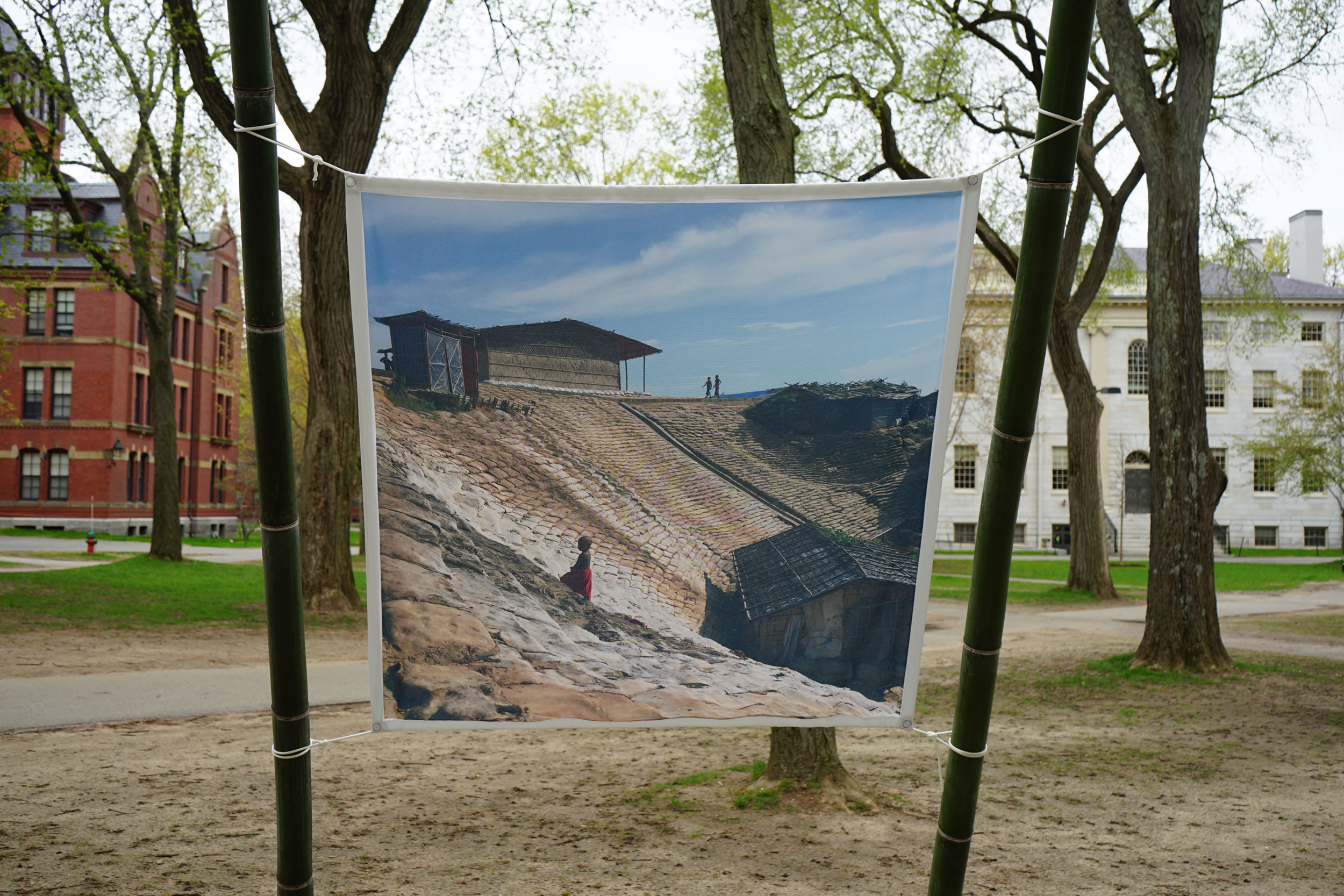
One of the shades in the Living Form installation on Harvard Yard.
We saw some of the very worst examples of what a society is reduced to when torn from place, space, and purposefulness of living, completely subsistent on external inputs and agency. In contrast, we saw rich, verdant vernacular rural communities whose land tenure practices, cultural norms, and livelihoods lived in synthesis and balance with their tended natural environment. We do not intend to downplay the extraordinary challenges and urgencies of the crisis, but rather challenge those providing response to the very worst of human circumstances to conceive of implementing real solutions within a visionary framework and anticipation of better alternatives to the long-term condition of refugee encampment.
This interview has been edited for length and clarity.
